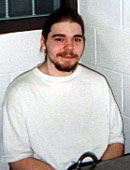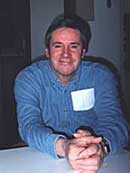
A Quiet Violence: Kids in Prison
by Cara Hetland
April 2000
 |
 |

|
Paul Jensen was tried as an adult because in South Dakota there is only one option for teenage murderers.
Photo: Cara Hetland
|
|
 |
| |
The average age in the South Dakota Penitentiary is 22. More and more 15- and 16-year-olds are sent there for non-violent offenses. It's an indication of society's get-tough approach toward troubled teens.
The century-old juvenile-court system was designed to keep kids out of adult prisons and focus on rehabilitation. Juvenile experts say reaction to recent school shootings is shaping a public policy aimed mainly at incarceration after the fact, rather than on prevention.
Corrections officials will not provide a breakdown of the prison population based on age and crime. They will only say most of the young boys at the penitentiary are serving time
for drug and alcohol offenses, burglaries and assault. Most will get out eventually, and few are labeled as violent.
Paul Dean Jensen was convicted of first-degree murder at the age of 14. He was one of the first teenagers sentenced as an adult. Jensen shot a Pierre cab driver three times after robbing him of $30. He was sentenced shortly after his 15th birthday.
According to court documents, the judge passed the harshest sentence possible because Paul Jensen showed no remorse. Jensen was tried as an adult because in South Dakota there is only one option for teenage murderers.
He's 18 now. He sits handcuffed to a metal table that's bolted to the wall. The sterile four-by-four interview room reverberates every sound.
"I'm not really violent, " Jensen contends. "I matured a lot. I'm not a stupid kid, that's what got me in trouble in the first place."
Kids on Death Row Too
Jensen says with the right environment and positive influences he could have turned his life around.
 |
 |

|
|
Larry Brendtro believes nearly every kid can be turned around. The president of Reclaiming Youth International says the solution to anti-social behavior is having adults show kids they care.
|
|
 |
| |
Sherilyn Jensen, Paul's mother, agrees. She says
Paul should have been sent to one of the handful of states that offer rehabilitation for violent teens. These programs also set them free at age 21. However, the state is under no obligation to send juveniles convicted of murder to out-of-state facilities.
South Dakota receives federal money for Jensen and other juveniles housed in the adult prison. South Dakota legislators voted this session to send juveniles to death row.
"Prison never really has helped many people or rehabilitated many people," says
Richard Quigley, the director of Minnesota's Woodland Hills. It's a treatment program for kids coming out of juvenile court. He says throwing a kid in an adult prison is a quick and easy fix to keep the scary kids off the street. "You tell me that's going to be some kind of a cure? It'll keep the child off the street, but you will eventually have to deal with that person."
Minnesota practices Extended Juvenile Jurisdiction. Most violent teenagers receive a sentence in both juvenile and adult court.
If a kid stays clean for long enough to satisfy the juvenile court sentence, he's free. But if he messes up, he has to serve his adult sentence.
"I've seen youngsters with prison sentences over their head of 90 months, or 120 months or 150 months if they don't straighten up and utilize the juvenile system seriously," Quigley says.
What Works?
What works for troubled teens is to balance a need for accountability while keeping people and communities safe.
Larry Brendtro believes nearly every kid can be turned around. The president of Reclaiming Youth International says the solution to anti-social behavior is having adults show kids they care. "Not in some touchy-feely sense," he says, "but in a sense of saying, 'This is not acceptable behavior and we are not going to give up on you.'"
"When science tells us an eight-year-old school bully has a 50-percent chance of being an adult felon by age 24, any informed person should clearly see we should put our resources into that kind of prevention."
Brendtro says we're giving up before we even try.
He points to a program in Idaho as a model for other states to follow. Idaho developed a separate juvenile department of corrections and is allocating money to the counties to open detention and counseling facilities. The restorative justice approach makes communities and families more responsible for troubled teens.
Sioux Falls family counselor J.C. Chambers says the approach is an effective way to reach out to kids. "It's training people how to meaningfully and fearlessly involve themselves with scary kids," he says. "We're seeing it's too easy to build walls, because these kids scare us. It's a little more difficult to get in the cell, take the handcuffs off and say, 'Okay, talk to me about why you do what you do.' A little more difficult to get past this generation's vibrato, but underneath, they're still kids."
Paul Dean Jensen, who is also a kid, will serve the rest of his life in the South Dakota State Penitentiary. He focuses on personal goals. He wants to stay out of what inmates refer to as "the hole" - an isolation cell. And he wants to stay off medication. But he still dreams.
"I do want to have a family. That hangs over my head. What can I do for them in here or out there? I'd stay out of trouble for them. I grew up, I'm not a stupid kid."
Without this dream, he says, he'll be hopeless and in the hole.
PREVIOUS: Young and Bad

![]()
![]()
![]()

![]()
![]()
![]()

![]()
